
The Hofner Colorama was the name given by British Hofner distributor Selmer, to a series of solid and semi-solid instruments sold with different model names in Europe and the USA. The Hofner Colorama, like all Hofners of this period, was made in Germany (Bubenreuth), where it would have been sold as the Hofner 162, (or the Hofner 160, with a single pickup). The Colorama, at this time, has echoes of the semi-solid Hofner Club, taking the same basic look and construction, but with less ornamentation, and accordingly a lower price. This similarity was short lived, with the model being modified, to a greater or lesser extent, almost continually through its period of production. Coloramas cover a wide range of body styles, construction methods and electronic configurations: the only real thing all variants have in common is a name.
Early examples had a single cutaway body style, a set neck, and from 1959-1960, a semi-solid construction consisting a solid block down it's middle, with a laminate wood top and back, making for an exceptionally light guitar. Although not one of the very first Coloramas, this example has the same construction, and weighs in at just 2.08kg! This hollow body with central block, is of course, the same build style as used by Gibson on their 335 guitars, but with a smaller body size and no sound holes. Furthermore Gibson routed pickup cavities, and embedded bridge posts through the top and into the central block; Hofner left everything floating, allowing maximum vibration from the top.
These are beautifully made guitars, perhaps missing some of the hardware and electrical improvements that would be added over the next five years or so, but the beautiful translucent nitrocellulose finish, easy playability and a nice woody tone, make for some of the nicest guitars to carry the Colorama name.
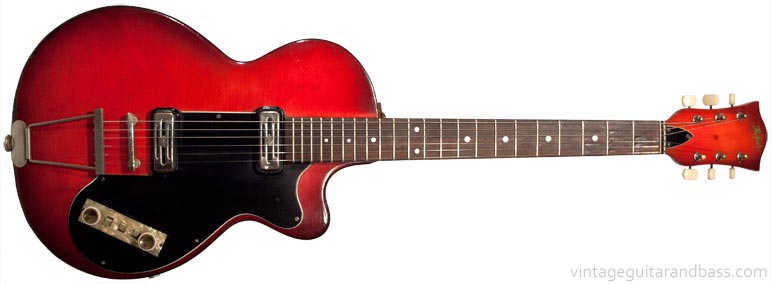
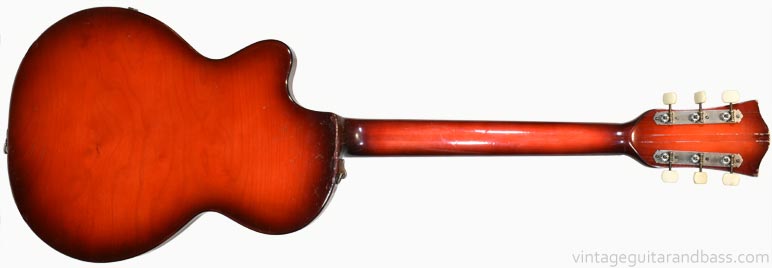
The Hofner Colorama was continually evolving over the years of its production, and it's impossible to define categoric specifications for any year. Just about any example is a snapshot of the Colorama at that time, rather than a representation of the model in more general terms. This Colorama hails from early 1960 (the potentiometers have the date code 459, signifying, week 45 (November) of 1959, see reading pot codes). As such it is one of the earliest guitars to be fitted with toaster pickups, and to be equipped with an adjustable truss rod - both significant improvements in terms of sound, set-up and playability.
Although not that apparent in these images, in the hand the quality of the finish is truly striking. Unlike later Coloramas, coated in polyester or even vinyl fabric, this has the most beautiful thin translucent nitrocellulose finish. The top and back are each a single piece of three-ply laminate - showing off all the grain. Naturally there are chips (especially near the strap hoops), and a whole lot of finish checking. It is fragile, not as hard-wearing as the later finishes, and more labour intensive (and therefore expensive) to produce. But, even for an entry level Hofner, the quality at this time (from the tradition of violin manufacture) is plain to see. These are beautiful guitars!
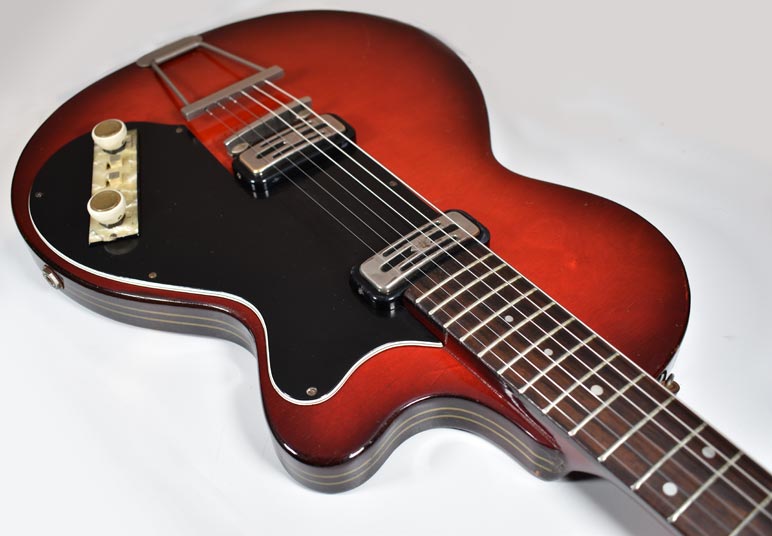
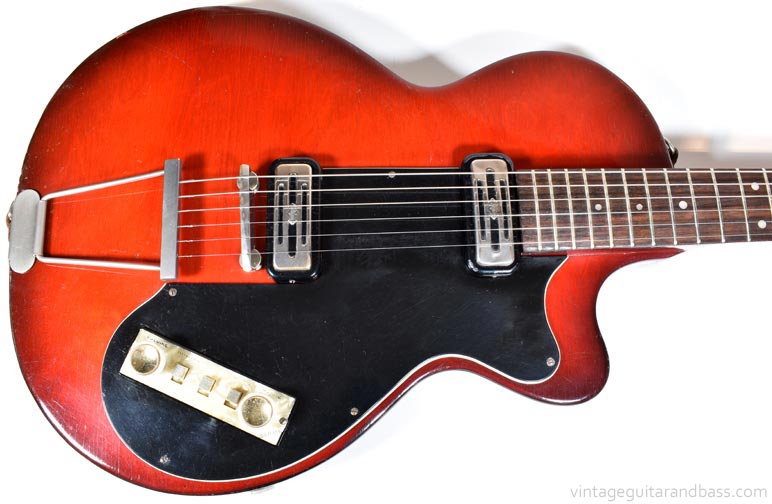
This 1960 Colorama has a trapeze tailpiece, floating bridge and pickups, and 5-screw pickguard (a template for this pickguard is available on the supporting member page for this guitar, here). Controls are quite typical for any dual pickup Hofner of this period, with a two pot, three switch console.
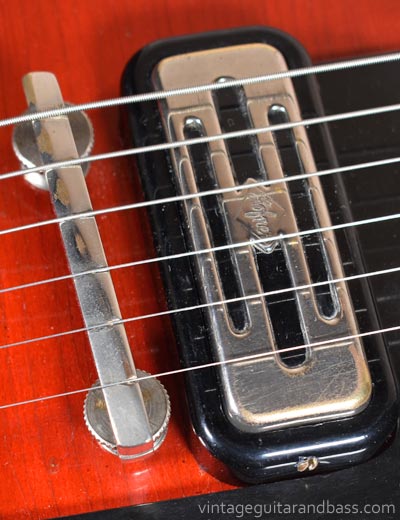
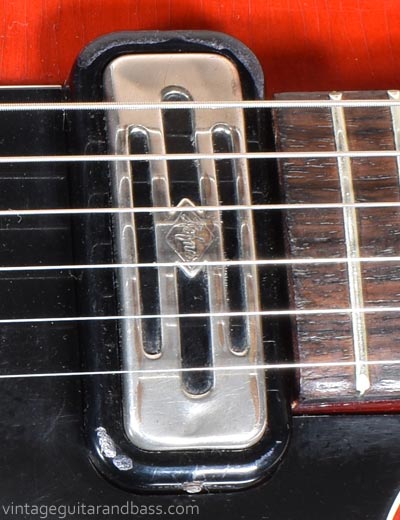
This early 1960 Colorama is fitted with two toaster pickups, both mounted in their plastic surrounds. These single coil units were short-lived, only appearing on guitars shipped in 1960 and early 1961. Although somewhat height adjustable, this was not always a simple matter! For more on height adjustment of these pickups see the additional images / description in the supporting members page. Earlier examples were fitted with rosewood or plastic bar pickups.
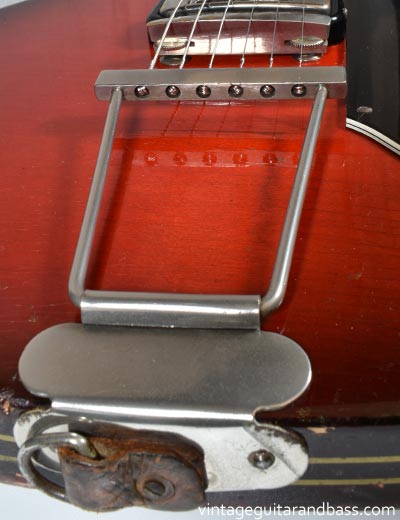
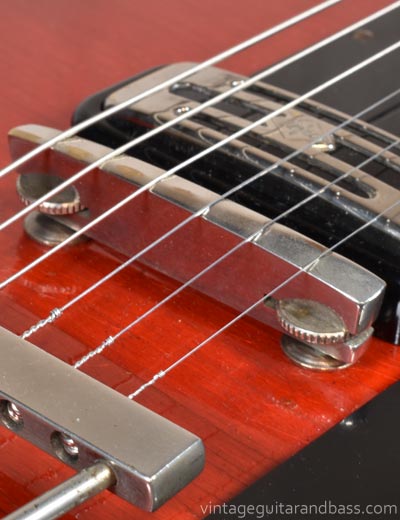
The edge of this guitar has painted gold parallel lines running around the entire body. The tailpiece is a typical Hofner trapeze tailpiece, matched with a floating nickel-plated height-adjustable brass bridge. Unlike slightly later versions, this bridge has two circular 'feet'. Compare with the bridge fitted to this 1961 Hofner Colorama.
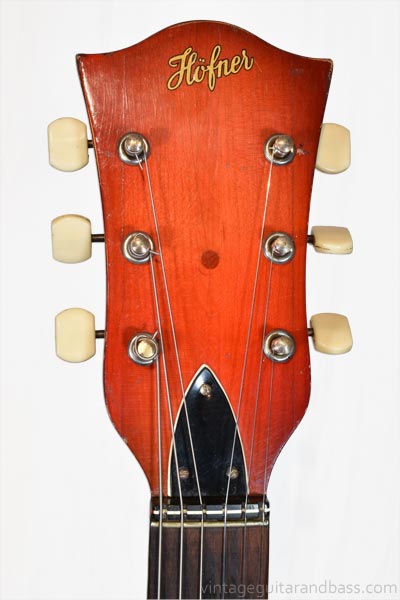
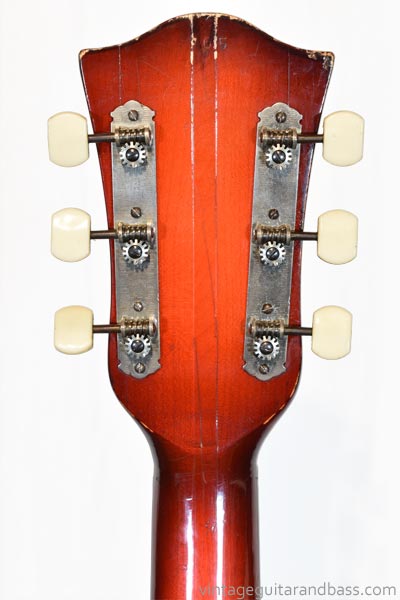
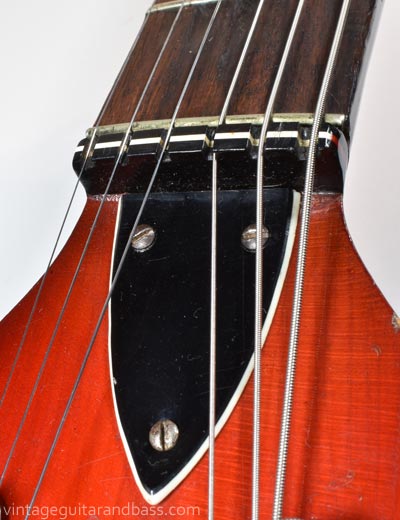
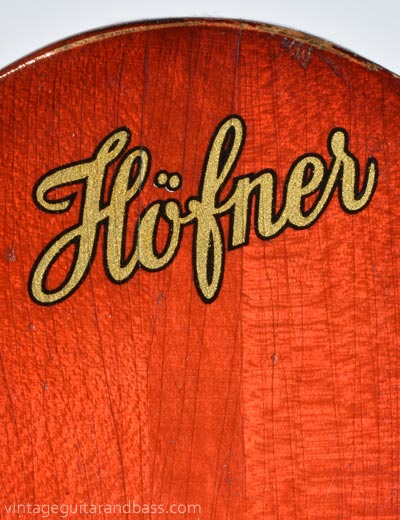
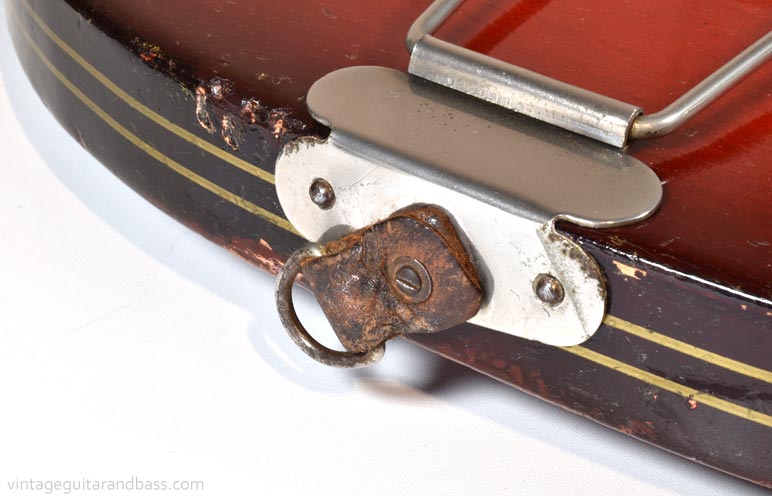
As mentioned near the top of this page, the Colorama evolved continually, generally benefiting from improved hardware hardware, but at the expense of finish and construction. At this relative primitive stage, the strap buttons are actually D-shaped metal rings, on a leather strap. As you can see above, the thin cellulose finish has been seriously worn by whatever metal hook or ring has been used to attach a strap, and has even been retouched slightly by a previous owner. The Colorama would have regular strap buttons by 1961 (compare with a 1961 Hofner Colorama).
The 1960 Colorama has the well known Hofner control consule fitted to many of their guitars. The actual operation of the console is less well known. There is a volume control for each pickup, and two tone settings via the switches.

There are five basic sounds as detailed below. From bassy to trebley:
Plus there are further variations in the 'both pickups' setting by adjusting the relative volume of each pickup. The above were recorded directly into a Focusrite Scarlett 2i2 USB recording interface (i.e. no amp) - but check out the video clips of the guitar in a more typical amplified situation further down the page.
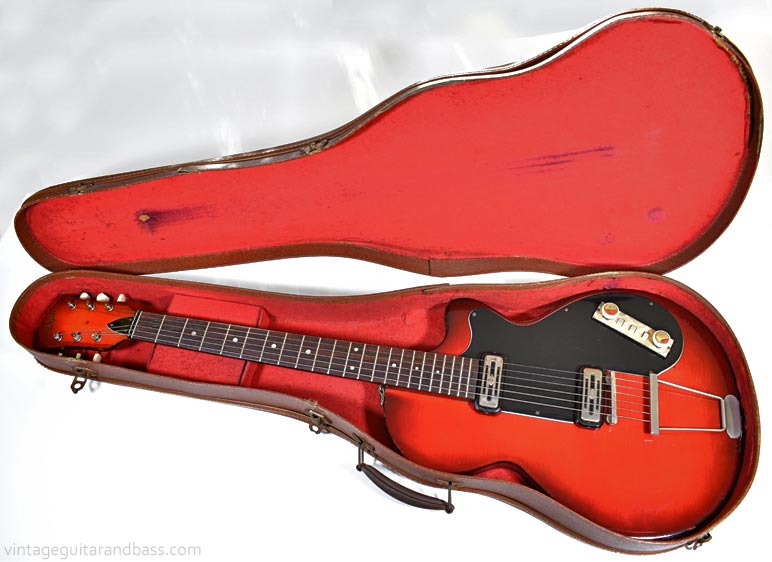
1960 Hofner Colorama / Hofner 162 in its original brown Selmer case. These were not the most hard waring of cases, but this one did its job, and kept this guitar safe for over 60 years (and counting).
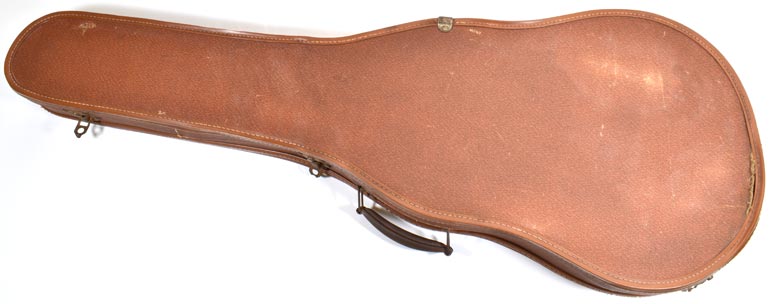
1960 Hofner Colorama case
All in all, a nicely made guitar, capturing some of Hofner's heritage of fine instrument manufacture; somewhat fragile in places, but exceedingly light and a lot of fun to play!
This is a cool little guitar. Easy playing, with a lovely resonance, and a nice basic tone from each pickup. The bridge pickup is a bit thin at lower volumes but really snarls with the amp gain upped somewhat. The neck alone is as fat as you like. Controls are a bit basic, and the floating bridge is a little bit more tricky to keep in tune than one with a fixed bridge and/or adjustable saddles. But it is what it is: full of character and a lot of fun to play.
Subscribe to the vintageguitarandbass youtube channel for more vintage guitar and bass demos. Also, check out the other Hofner Colorama videos (different amps, different settings) in the supporting members area.
Find out more about this amp here 1963 WEM ER-15
This is a great little guitar - and it sounds pretty cool through the WEM ER15. The Hofner Colorama was sold by Selmer in the UK 1958-1965: yet the several different guitars were included under the moniker at different times. In 1960 it was a nice set-neck semi-solid - and one of the lightest guitars i've ever played! The controls are not totally intuitive, but the five basic settings have real character. These are 1) both pickups 2) neck pickup 3) neck pickup with treble cut 4) bridge pickup 5) bridge pickup with bass cut.
Recorded here with a Heil PR-40 (left channel) and a Shure SM57 (right channel), through a Focusrite Scarlett 2i2 interface - highly recommended gear!
Find out more about this amp here 1963 WEM ER-15
Long version of this video with extra amp and guitar settings. The treble pickup is biting, the 'bass on' (neck pickup + treble cut filter) is fat and warm. Very easy to alternate between jagged stabs and lazy laid back jazz.
Recorded here with a Heil PR-40 (left channel) and a Shure SM57 (right channel), through a Focusrite Scarlett 2i2 interface - highly recommended gear!
Extra content on this guitar is included in the Supporting Members area here
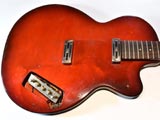
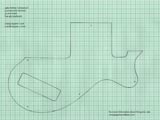
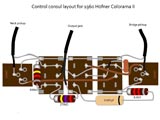
$899
$250
£1200
C $1215
£604
£593
€2290
£219
£338
£195
£721